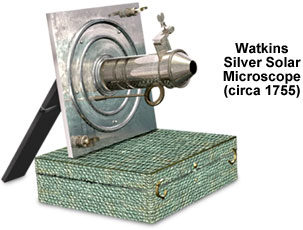Watkins Silver Solar Microscope
The Watkins silver solar microscope is part of a 1750s microscope compendium that also included a universal compound microscope, accessories, an accessory box, and a mahogany storage case. The drawing featured below was modeled from a photograph and description featured in Gerard Turner's book entitled Collecting Microscopes.

Following the publication of John Cuff's solar microscope design in Henry Baker's book entitled The Microscope Made Easy (1742), London craftsman Francis Watkins created his own version of the instrument. A Wilson-type screw-barrel simple microscope acts as the projection lens for the Watkins device, while a square shutter plate is designed to fasten into a window with the help of two silver, winged screws. A rectangular mirror, shown above as supporting the instrument, may be adjusted for optimal specimen illumination, and the microscope barrel, mounted in a scioptic ball, is also rotatable. Bone or ivory sliders with mounted specimens can be inserted into a slot on the microscope barrel and held in place by an adjustable stage and thumbscrew. The microscope, which is part of the Royal Microscopical Society collection, is signed "Fra. Watkins Charing Cross London" and bears the hallmark of the London Assayer's Office, "Goldsmith's Hall, 1754/1755".
Watkins published a 98-page treatise, entitled L'Exercise du Microscope, in 1754, in which he fully describes the silver microscope compendium. One of its components that is illustrated above with the solar microscope is the accessory box covered in green-dyed, stingray skin. Lined in green velvet, the sleek case included two silver wet cells, a fish-plate, stage forceps, a live box, three Lieberkühn reflectors, and 11 ivory sliders in a small silver box.
BACK TO EIGHTEENTH CENTURY MICROSCOPES
